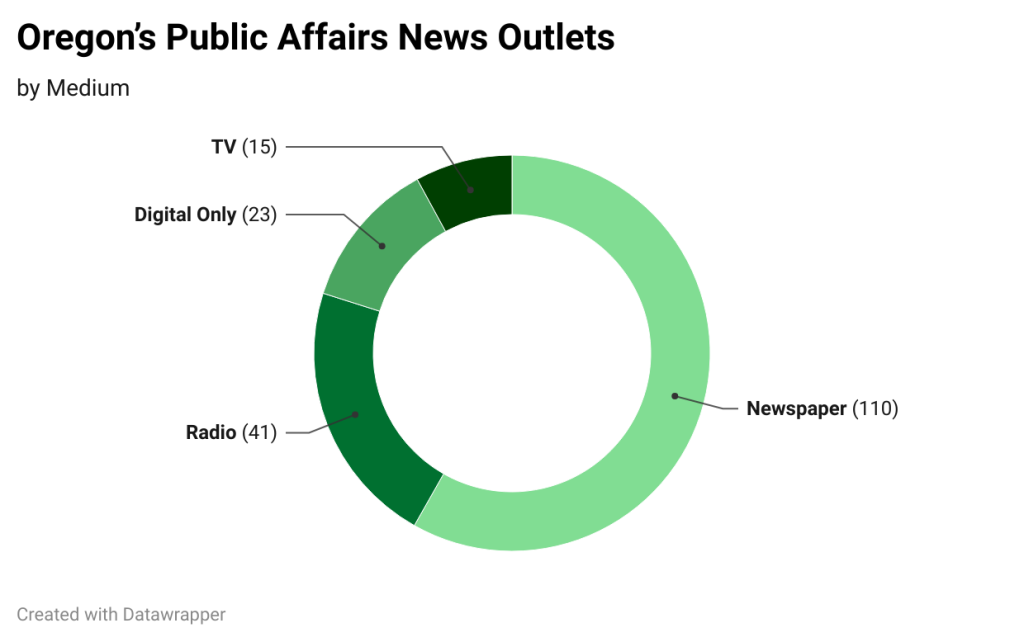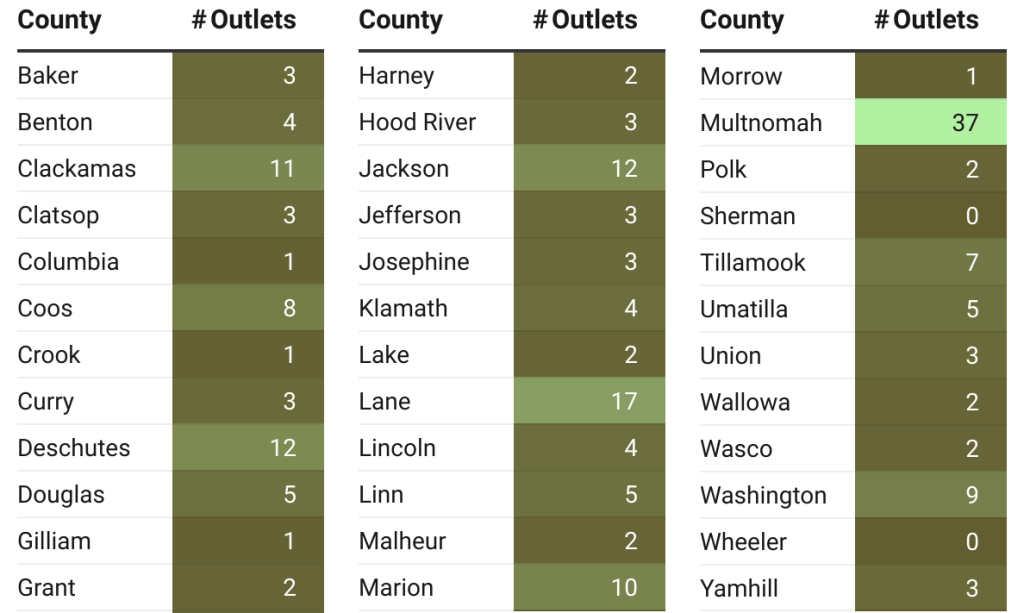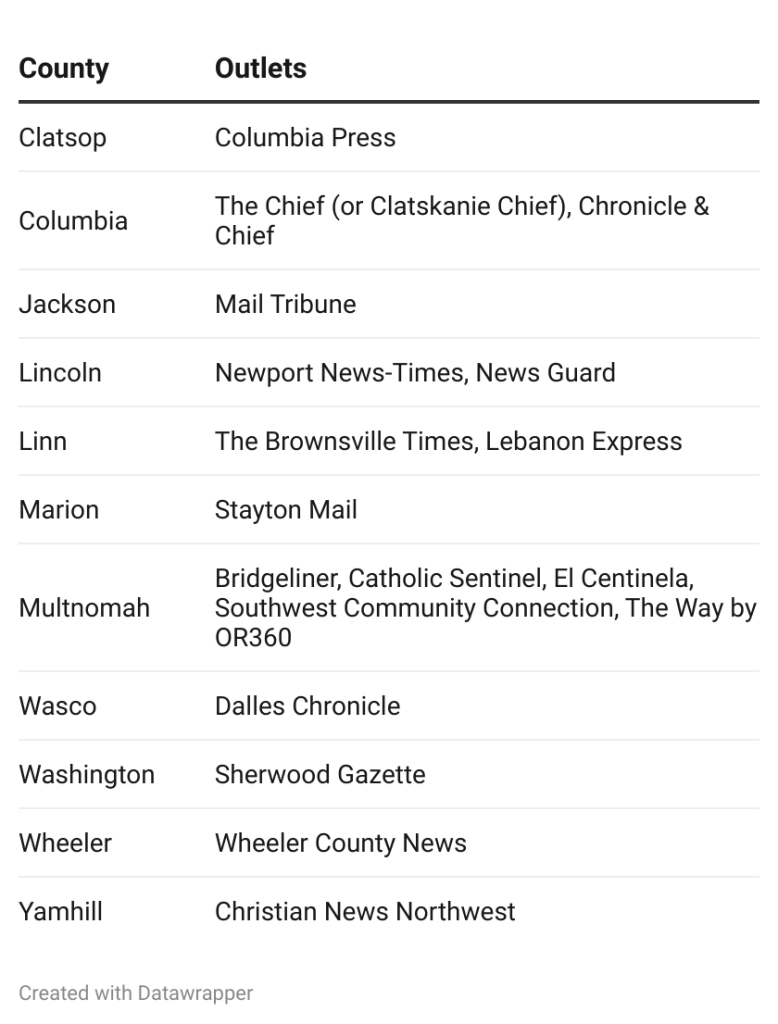In 2022, we released the first-ever attempt to identify and map all newspapers, radio and TV stations, and digital-first publications in Oregon that were regularly producing original, local, civically relevant content. For this report, we’ve updated that database, reviewing each entry to see what has changed (and in some cases, things we missed in 2022).
Readers should note the limitations built into this database: It includes no commercial radio stations (since research indicates the public affairs content on commercial radio is, in general, extremely limited1 Jessica Mahone, Wun Wang, Philip Napoli, Matthew Weber, & Katie McCullough, “Who’s producing local journalism? Assessing journalistic output across different outlet types” (August 2019), DeWitt Wallace Center for Media & Democracy, p. 3. https://dewitt.sanford.duke.edu/whos-producing-local-journalism-nmrp-report/) and no stand-alone social media sites (which are very important to understanding how news is shared but are difficult to capture comprehensively); nor did we include public radio “repeater” stations that help radio station signals reach broader areas. The database also only reflects outlets that have a digital presence, which in most cases means a full-blown website, but for some small news outlets may mean a collection of online PDFs.
When updating the database we tried to re-assess whether outlets are producing public affairs content, such as coverage of local government and politics, environment, education, health, fire, crime, courts and law, economic issues, transportation, housing, and other public issues. Based on this re-analysis, we removed a few outlets from the updated database. We acknowledge the very important role played by local publications focusing exclusively on the arts, food, travel, outdoor recreation, and other lifestyle coverage for the civic vibrance of communities. For this report, however, we wanted to zero in on the news most essential to the democratic life of communities and most threatened by changes in the digital information environment: coverage of policy, politics, government, social issues, and public affairs. We included outlets that appear to regularly (if not exclusively) carry that kind of coverage. We also did not include outlets that appear to routinely mix commentary with news. Readers are encouraged to see the Methods appendix for details on how the database was assembled and updated.
Readers should also note that the main database excludes a small but important category of outlets that regularly produce original public affairs news about Oregon and other states in the Pacific Northwest: outlets like ProPublica Northwest, Investigate West, and the Columbia Basin Bulletin. These publications represent an important component of the local news ecosystem, especially for Oregonians who live, work, and travel across state boundaries. While important to the overall news coverage of our state, these regional outlets are not physically housed in Oregon and do not report only on Oregon. We have included them on a separate tab of the database, but we have not included them in the statistical descriptions and analyses below in order to focus squarely on the state of local media within Oregon.
It’s also important to bear in mind that the statistics and graphics in this report offer a point-in-time snapshot that will grow less accurate over time as changes unfold in Oregon’s local news ecosystem. Readers can find our database and provide feedback.
News Outlets Across Oregon, 2025
Based on the criteria described above, we counted 189 media outlets in Oregon that are regularly providing local public affairs news content.
Our research indicates that newspapers comprise 58% of news outlets in Oregon (defined by the criteria above), followed by public radio stations (22%). Digital news outlets comprise 12% of the media outlets in our dataset, and television stations almost 8%. Of course, these percentages do not reflect the audience size or reach of any individual outlet.

Just as we found in 2022, Oregonians living in different parts of the state have widely varying access to local news. Areas with higher population density tend to have more news outlets serving them—a pattern identified in studies of other locations around the U.S.2 See for example Nikki Usher (2021) News for the Rich, White, and Blue: How place and power distort American journalism (New York: Columbia University Press). Many of the areas of the state with lower population density are also geographically large, however, meaning that it can be harder for the few news outlets covering those areas to effectively cover all communities. The uneven distribution of outlets also means that, for some communities, if even one local outlet is at risk of shrinking or disappearing, the impact for those communities is greater. And we find two Oregon counties—Sherman and Wheeler—that are “news deserts” in the sense that we could not identify any functioning news outlet physically located in those counties.

As described in the opening section of this report, a number of Oregon’s news outlets have closed since our first report was published in late 2022. According to our research, that list includes:

Counting news outlets in terms of their physical location is only one way of assessing the health of local news ecosystems. In fact, even in areas with a relative wealth of local media, residents are not necessarily well informed and civically engaged. Other approaches involve mapping local news in terms of media outlets’ coverage areas, rather than where they are physically housed. In other words, an outlet’s bricks and mortar location is not always the best indicator of the broader swath of communities it actually reaches. For example, the Times-Journal, based in Condon, is considered the newspaper of record for three Oregon counties (Gilliam, Sherman, and Wheeler), and regularly produces news about those counties. But its physical location in Condon means that Sherman and Wheeler counties appear on our map to lack access to local news. In fact, the Times-Journal attempts to cover all three counties, and if we were mapping in terms of coverage area, those counties would look different on our map. With these caveats in mind, there is still value in documenting what remains and what has disappeared in terms of Oregon-based news media, because it is one important indicator of the state’s local news production capacity. The disappearance of individual newsrooms almost inevitably signals the loss of at least some capacity to cover local communities.
That said, it’s also important to remember that news consumers today get their news via many pathways. Documenting news production capacity is not the same as documenting where Oregonians are actually turning for local news and information. Future research needs to explore Oregonians’ news consumption habits in a more comprehensive and granular way.